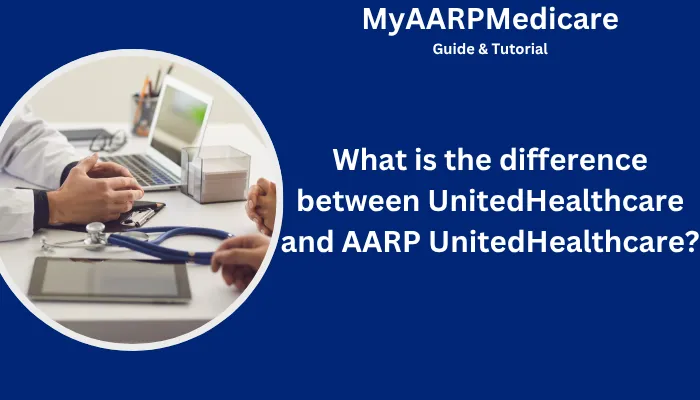I’ve been navigating the world of health insurance for years, and I know how confusing it can be to sort through the options. One question I hear often is, “What is the difference between UnitedHealthcare and AARP UnitedHealthcare?” If you’re exploring MyAARPMedicare or other platforms to find the right plan, you’re likely wondering the same.
In this guide, I’ll break down the distinctions in a clear, engaging way, using my experience to help you understand how these two entities work together and what that means for you. Let’s dive in and make sense of it all.

UnitedHealthcare: The Insurance Giant
I’ve seen how UnitedHealthcare stands out as a powerhouse in the insurance world. It’s one of the largest health insurance providers in the United States, offering a wide range of plans for individuals, employers, and Medicare beneficiaries.
- Operates as a for-profit company under UnitedHealth Group.
- Provides health insurance across all 50 states.
- Covers individuals, families, and Medicare-eligible seniors.
- Offers Medicare Advantage, Part D prescription drug plans, and Medigap (supplemental) plans.
- Serves over 4.5 million retirees nationwide with Medicare plans.
UnitedHealthcare’s massive network includes over 1.7 million physicians and 7,000 hospitals, making it a go-to for many. But when you see “AARP UnitedHealthcare,” you might wonder, “What is the difference between UnitedHealthcare and AARP UnitedHealthcare?” Let’s move to the next section to explore this.
I’ve laid the groundwork for UnitedHealthcare’s role, so now let’s look at how AARP fits into the picture with its unique partnership.
AARP: The Senior Advocate with a Twist
I’ve always admired AARP’s mission to empower people over 50, but their role in insurance is a bit more complex. AARP, founded in 1958, is a nonprofit organization focused on improving the lives of older adults through advocacy, education, and resources.
- Boasts nearly 38 million members nationwide.
- Offers benefits like discounts, educational materials, and community programs.
- Partners with companies to provide branded products, including health insurance.
- Does not act as an insurer but endorses specific plans.
AARP’s partnership with UnitedHealthcare creates the “AARP UnitedHealthcare” branding you see on Medicare plans. So, what is the difference between UnitedHealthcare and AARP UnitedHealthcare? It’s about this collaboration, which we’ll dive into next.
I’ve covered AARP’s role as an advocate, so let’s explore how their partnership with UnitedHealthcare shapes the plans you’re considering.
The Partnership: AARP and UnitedHealthcare
I’ve dug into the details of this partnership, and it’s fascinating how it works. AARP doesn’t sell insurance directly but licenses its name to UnitedHealthcare for specific Medicare plans.
UnitedHealthcare pays AARP royalty fees for using their brand, which adds a layer to the question, “What is the difference between UnitedHealthcare and AARP UnitedHealthcare?”
Here’s how it breaks down:
- Branding: AARP UnitedHealthcare plans carry the AARP name, signaling trust and quality for seniors.
- Exclusivity: AARP only endorses UnitedHealthcare for Medicare-related plans, not other insurers.
- Royalties: UnitedHealthcare pays AARP a 4.95% royalty fee on premiums, which supports AARP’s programs.
- Membership Requirement: For AARP-branded Medigap plans, you need an AARP membership ($16-$20 annually).
This partnership began over 25 years ago, and it’s designed to make UnitedHealthcare’s Medicare plans more appealing to seniors. But the core insurance product comes from UnitedHealthcare, not AARP.
To illustrate, here’s a table comparing key aspects:
| Feature | UnitedHealthcare | AARP UnitedHealthcare |
|---|---|---|
| Provider | UnitedHealthcare | UnitedHealthcare with AARP branding |
| Plan Types | Medicare Advantage, Part D, Medigap | Same, but AARP-endorsed |
| Membership | No membership required | AARP membership for Medigap plans |
| Network Size | 1.7M+ physicians, 7,000+ hospitals | Same network |
| Royalty Fees | None | 4.95% of premiums to AARP |
This table answers, “What is the difference between UnitedHealthcare and AARP UnitedHealthcare?” by showing that the plans are fundamentally the same, but AARP’s endorsement adds a layer of trust and a membership requirement for some plans.
I’ve unpacked the partnership, so let’s look at the specific plans offered under the AARP UnitedHealthcare banner to see how they work.
Types of AARP UnitedHealthcare Plans
I’ve explored the plans offered under this partnership, and they’re tailored to meet seniors’ needs. AARP UnitedHealthcare offers three main types of Medicare plans, all insured by UnitedHealthcare:
1. Medicare Advantage (Part C):
- Combines Parts A and B, often including prescription drug coverage.
- Offers extras like dental, vision, and fitness benefits.
- Average cost: $24/month, with some $0 premium plans available.
2. Medicare Part D (Prescription Drug Plans):
- Covers generic and brand-name medications.
- Varies by formulary, premiums, and copays.
- Often paired with Medigap for comprehensive coverage.
3. Medigap (Medicare Supplement):
- Covers out-of-pocket costs like coinsurance and deductibles.
- Requires AARP membership for enrollment.
- Plans like G or F are standardized but may include extras like gym memberships.
These plans don’t differ in coverage from UnitedHealthcare’s non-AARP-branded plans, but the AARP name adds a layer of trust. So, what is the difference between UnitedHealthcare and AARP UnitedHealthcare? It’s mainly the branding and the membership requirements for Medigap.
I’ve outlined the plan types, so let’s address some concerns about this partnership to give you a fuller picture.
Concerns and Criticisms
I’ve heard plenty of feedback about this partnership, and not all of it is glowing. Some seniors question the relationship, especially given UnitedHealthcare’s reputation for claim denials (32% denial rate vs. industry average of 16%). Here are key concerns:
- Royalty Fees: AARP earns significant revenue ($905 million in health insurance royalties in 2023), raising questions about whether they prioritize members or profits.
- Customer Service: UnitedHealthcare’s customer service scores lower (3.6-3.7 stars) compared to competitors like Humana.
- Transparency: Some feel AARP doesn’t clearly disclose the royalty arrangement, which can make premiums feel inflated.
Despite these issues, many appreciate the large provider network and extra benefits.
When asking, “What is the difference between UnitedHealthcare and AARP UnitedHealthcare?” it’s worth noting that the insurance product is identical, but AARP’s involvement adds a financial layer that not everyone loves.
I’ve addressed the criticisms, so let’s wrap up with some tips to help you choose the right plan.
Choosing the Right Plan
I’ve guided many people through picking Medicare plans, and here’s my advice for you:
- Assess Your Needs: Consider your health conditions, preferred doctors, and budget.
- Compare Plans: Use Medicare’s Plan Finder to compare AARP UnitedHealthcare plans with others.
- Check the Network: Ensure your doctors and hospitals are in-network to avoid extra costs.
- Review Extras: Look at benefits like dental or vision, if they matter to you.
- Understand Costs: Factor in premiums, copays, and AARP membership fees for Medigap.
By following these steps, you’ll answer, “What is the difference between UnitedHealthcare and AARP UnitedHealthcare?” for yourself and choose a plan that fits. I’ve shared my best tips, so you’re ready to make an informed decision with confidence.
Conclusion
I’ve walked you through the ins and outs of health insurance, and I hope it’s clearer now. The question, “What is the difference between UnitedHealthcare and AARP UnitedHealthcare?” boils down to branding, AARP membership requirements, and royalty fees.
Both offer the same UnitedHealthcare plans, but AARP’s endorsement adds trust and a small cost. Use my guide to weigh your options, compare plans, and pick what suits your life. With this knowledge, I’m confident you’ll find the right coverage for a healthier, happier future.
